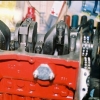Cylinder Head Studs
#1

Posted 06 April 2014 - 11:47 AM
Fairly new to minis and engines and currently replacing head gasket on a 1098 A series engine, when removing the cylinder head on a few of the studs, instead of the nut coming off the whole stud came off and was wondering how you put the studs back in and do you have to torque them?
Cheers
Lewis :)
#2

Posted 06 April 2014 - 11:57 AM
#3

Posted 06 April 2014 - 01:26 PM
#4

Posted 06 April 2014 - 03:01 PM
#5

Posted 06 April 2014 - 05:38 PM
That is wrong. There is NO NEED to turn them back half a turn, in fact it is completely pointless and weakens the lower end of the stud fixing. Just double nut them, and screw in hand tight with a socket or spanner, If you want a torque, 20 lb ft will be adequate. The exact figure is not all that important, as long as they are BOTTOMED in the thread, and that goes for ALL studs, e.g manifold, unless otherwise specified.
#6

Posted 06 April 2014 - 06:05 PM
No torque needed to install just the stud. Usually thread them in to the bottom and then turn them out 1/2 of a turn. You might run a tap in the holes to clean them up if there is any junk in there.
That's probably why the stud(s) came out with the nuts.Turning them back means they are loose.
#7

Posted 06 April 2014 - 08:17 PM
Exactly!
#8

Posted 07 April 2014 - 04:38 AM
Studs should be screwed into the block hand tight only ![]() - no need to torque them up, nothing terrible will happen if you don't.
- no need to torque them up, nothing terrible will happen if you don't.
ARP suggest studs should be finger tight only. Thinking about it - the stud probably shouldn't bottom out before the thread runs out.
This discussion is rather like my wife asking whether she should put the icecream in the freezer.
#9

Posted 07 April 2014 - 07:16 AM
#10

Posted 07 April 2014 - 10:35 AM
Would use some loctite on the thread..
#11

Posted 07 April 2014 - 10:49 AM
Dont use loctite, and just torque them finger tight, there shouldnt be a problem if the threads are clean.
Studs must be clean and not oiled.
Take care that they're straight: gently slide the head gasket in position, if you see the gasket catching on a stud, gently tap it using two hammers one against each other (so you wont be hammering the threads..)
#12

Posted 07 April 2014 - 10:51 AM
Edited by Dan, 07 April 2014 - 10:56 AM.
#13

Posted 07 April 2014 - 11:06 AM
#14

Posted 07 April 2014 - 12:22 PM
Yes, 20 lb ft is not excessive, and I only suggested that particular value because it is nowhere near the maximum, but probably enough to discourage the stud from unscrewing next time the nut is removed, which "finger tight" will not do. It is a sort of mid range torque, tight but not near the elastic limit. The tension in the stud is the same throughout its length, but the bottom end must be engaged fully in the thread in the block, which is why some reasonable value of torque must be applied. If the thread is not FULLY engaged, there is a good chance of stripping the weaker block casting when the head nut is torqued up. And, Loctite does no harm at all, although I don't think I would bother to use it there, as when the head nuts are torqued up, the studs having been fully engaged with the block threads, there is usually more than sufficient friction to prevent things working loose.
I have had to replace more than a few head studs over the years, on Minis, Triumph Heralds, and various others, mostly very similar, i.e. 3/8" UNF, and have always screwed them in tight, with zero failures. Those which broke, on first re-torquing, were on cheap reconditioned engines, where the studs had been re-used and probably torqued up well beyond their fatigue threshold multiple times. None fitted by me, and torqued up as per the relevant manual, ever failed, although in some cases I had the head off more than a few times for other reasons. So, I have never experienceed, nor would I expect to ever see a failure, caused simply by nipping up the studs in the block to less than half their rated torque.
I have known of people, and even seen it happen, who have destroyed a good block by screwing in a stud forcibly, with oil or water in the blind hole, so that the stud does not bottom, but instead pressurises the incompressible liquid. But even so, failure will only occur at a torque greater than the rated torque of the stud, and even if there is a hydraulic lock, 20 lb ft can not and will not break anything. But, if the stud does not bottom, and is sitting too high, there is insufficient thread engagement, so it needs to come out and have the hole cleaned. Forcing it in regardless, as cowboys do, can only end badly. I don't think there are many intentional cowboys here, and am quite sure that the vast majority of us do clean out tapped holes before inserting bolts or studs, so that particular problem is not likely to happen very often. Just as well, because a block fractured around a stud hole will in almost all cases be scrap.
There is a much bigger problem here. The efficiency of a typical screw thread is up to about 22% if lubricated, and maybe 12% normally, down even to 5% if very dry. Now that means that 22%, 12% or maybe only 5% of the applied torque is being converted to tension in the stud, and it is the tension that provides the clamping load for the head gasket. It MUST be higher than the dynamic load caused by the combustion process, or rapid failure will occur, yet it is that same tension that needs to be within the elastic limit of the stud (stretch bolts are not used normally on Minis and make things even more complicated).
So instead of arguments about the imagined risks of screwing the studs in tight, attention should be focussed on how to CONSISTENTLY get the correct STUD TENSION, despite the vagaries of fairly unpredictable friction. Get that right, and the incidence of failed gaskets, and warped heads, and even blocks, will be very greatly reduced. Gasket failure used to be quite rare in Minis, even if occasionally overheated, but on the forum it seems to be fairly common nowadays, and it may be that the problem is due to less accurate methods of tightening the head nuts being used these days. (It is known that one particular and fairly modern and expensive gasket is best, so there "should" have been a reduction in failures, not an increase.) I for one am very interested in constructive suggestions. So far, the best method appears to be the use of special force-indicating washers, which are not cheap and can only be used once., but it may be feasible to use a high performance lubricant on the threads, for consistency, and re-calculate the torque to a lower value than is customarily used, to get the intended tension. Or, of course, there is the possibility of stretch bolts, only to be used once as per most modern engines, which are effectively constant tension when taken into the plastic deformation region. Or, just maybe, an allegedly reusable SmartBolt:
Edit: The SmartBolt starts at 7/16" or M10. Not sure if there is enough meat in a Mini block and head to drill them out to what is the next size up.
Edited by tiger99, 07 April 2014 - 12:28 PM.
#15

Posted 07 April 2014 - 05:09 PM
1 user(s) are reading this topic
0 members, 1 guests, 0 anonymous users




















